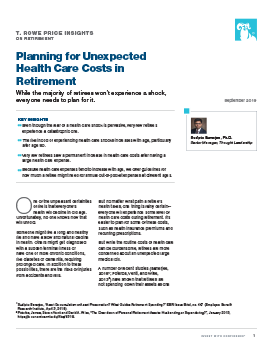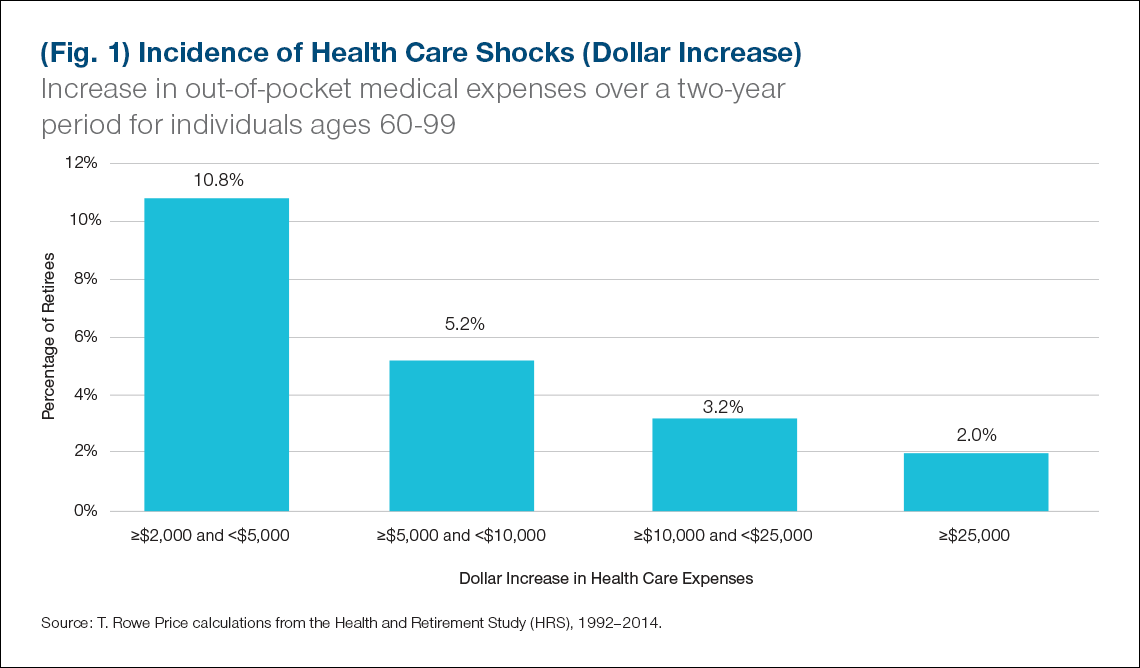
Planning for Unexpected Health Care Costs in Retirement
While the majority of retirees won’t experience a shock, everyone needs to plan for it.
Key Insights
- Even though the fear of a health care shock is pervasive, very few retirees experience a catastrophic one.
- The likelihood of experiencing health care shocks increases with age, particularly after age 80.
- Very few retirees saw a permanent increase in health care costs after having a large health care expense.
- Because health care expenses tend to increase with age, we offer guidelines for how much a retiree might need for annual out-of-pocket expenses at different ages.

One of the unpleasant certainties of life is that everyone’s health will decline in old age.
Unfortunately, no one knows how that will unfold.
Someone might live a long and healthy life and have a slow and natural decline in health. Others might get diagnosed with a sudden terminal illness or have one or more chronic conditions, like diabetes or dementia, requiring prolonged care. In addition to these possibilities, there are the risks of injuries from accidents and falls.
But no matter what path a retiree’s health takes, one thing is fairly certain— everyone will experience some level of health care costs during retirement. It’s easier to plan for some of these costs, such as health insurance premiums and recurring prescriptions.
But while the routine costs of health care can be burdensome, retirees are more concerned about an unexpected large medical bill.
“In order to help retirees create a successful retirement income strategy we need to better understand the likelihood and the magnitude of uncertain health care costs."
-- Sudipto Banerjee, Ph.D. Senior Manager, Thought Leadership
Studies have shown that retirees are not spending down their assets as one might expect.
A number of recent studies (Banerjee, 20181; Poterba, Venti, and Wise, 20132) have shown that retirees are not spending down their assets as one might expect. Retirees may be hesitant to spend their hard-earned money out of fear or in preparation for these health care expenses. In order to help retirees create a successful retirement income strategy that balances the need for current spending and future health care expenses, we need to better understand the likelihood and the magnitude of these uncertain health care costs.
This paper will explore the probability that a retiree will experience a health care-related financial shock and the chances of the higher expense becoming a new normal, resulting in higher future expense. We will also look at how gender, age, and income play a role, if any.

About Our Study
We used data from the Health and Retirement Study (HRS), which is a nationally representative survey of Americans ages 50 and older. HRS has interviewed its respondents every year starting in 1992. We looked at people who were between 60 and 99 years old from 1992 to 2014. All costs are adjusted for medical inflation and expressed in 2014 dollars.6 Since the survey is conducted every two years; respondents report their out-of-pocket health care costs for the preceding two years. As a result, the increases reported are for two-year periods.
1. Sudipto Banerjee, “Asset Decumulation or Asset Preservation? What Guides Retirement Spending?” EBRI Issue Brief, no. 447 (Employee Benefit Research Institute, April 3, 2018).
2. Poterba, James, Steven Venti and David A. Wise, “The Drawdown of Personal Retirement Assets: Husbanding or Squandering?”, January 2013, https://economics.mit.edu/files/6318.
Important Information This material is provided for general and educational purposes only and is not intended to provide legal, tax, or investment advice. This material does not provide fiduciary recommendations concerning investments or investment management. This material is provided for informational purposes only and is not intended to be investment advice or a recommendation to take any particular investment action. The views contained herein are those of the authors as of September 2019 and are subject to change without notice; these views may differ from those of other T. Rowe Price associates. All investments involve risk. All charts and tables are shown for illustrative purposes only.
T. Rowe Price Investment Services, Inc., Distributor.
Contact your T. Rowe Price representative to find out how we can take your plan to the next level.